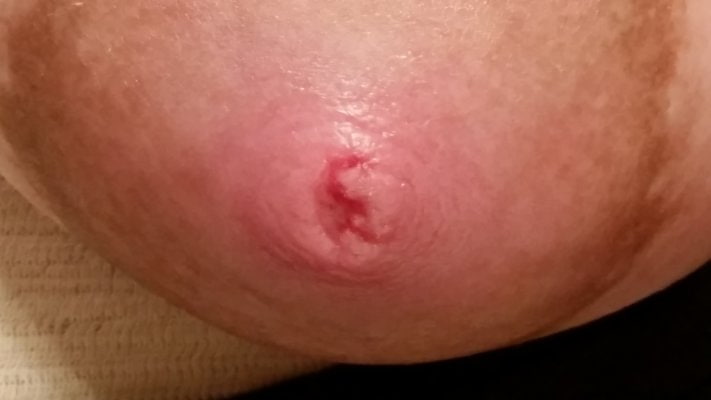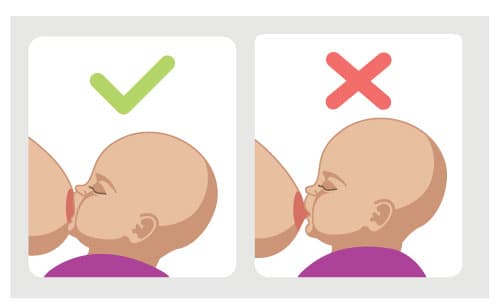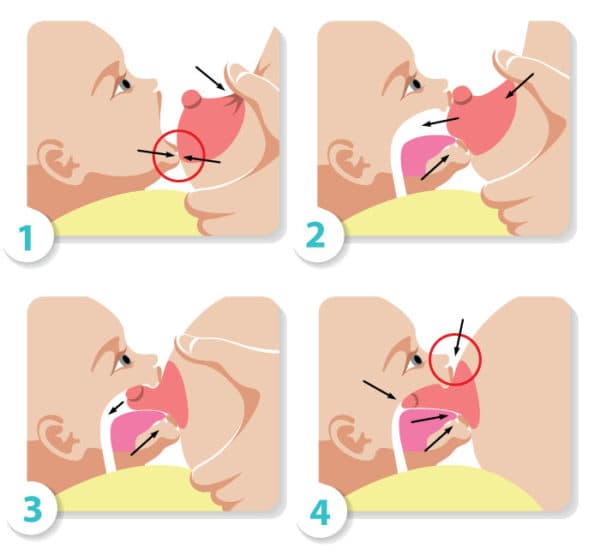Cracked Nipple: Causes, Symptoms, Diagnosis & Treatment
Experts state that the formation of cracked nipples, which can often be seen in breastfeeding mothers, can sometimes be very disturbing and may cause the mother to avoid breastfeeding and ultimately the baby not getting enough of breast milk.
Nipple cracks can be encountered during the entire breastfeeding period, especially at the beginning of breastfeeding. This can cause pain and distress to the mother.
Nipple fissures may occur around the nipple, as a transverse line on the nipple, or in the areola.

What Will We Learn?
Why Do Nipple Cracks Occur?
The most common cause of nipple cracks is that the baby’s sucking position and holding is not correct. Nipple cracks and clefts occur due to the use of faulty breastfeeding techniques by approximately 30% of new mothers.
If the baby does not fully grasp the brown ring around the nipple, called the areola, while sucking on its mother, and tries to suckle only from the nipple, the nipple will eventually be damaged.
First, the painful nipple appears. If this painful breast condition is not corrected, nipple cracks and clefts develop.
Another reason is the wetting and drying of the nipples during the lactation period and the drying of the nipples as a result of the constant humidity and temperature created by the baby’s breast sucking.
In this case, cracks occur in the nipples and cause eczema, which is evident with painful clefts.

What Problems Do Cracked Nipples Cause For Mother And Baby?
The main problem with the cracking of the nipple is that microbes easily enter through these cracks and cause inflammation of the breast.
In addition, cracked nipples cause painful breastfeeding, which results in the mother not being able to give enough milk and ultimately milk accumulation in the breasts.
Breastfeeding is the period that strengthens the emotional bond between mother and baby.
Some of the mothers cannot breastfeed their babies due to nipple problems (such as crack formation, pain, eczema, fungal infection, mastitis) during breastfeeding.
Thus, the period when babies receive breast milk is shortened.
The more often a mother breastfeeds her baby, the more milk is produced.
Considering the importance of breast milk for the baby, it is very important for the health of the baby that the baby is not separated from the milk early.
Today, many benefits of breast milk for the baby and the mother are known. If we touch on these briefly: Breast milk is the best food that can provide all the nutrients that babies need for the first 6 months.
Breast milk is known to protect the baby from diarrhea, respiratory tract infections and bacterial meningitis.
Studies have shown that breastfed children are more resistant to diseases such as asthma, allergies and diabetes, and the rate of cancer in these children is lower.
Breastfeeding immediately after birth reduces the risk of postpartum hemorrhage in the mother.
Breastfeeding is known to protect the mother from urinary tract infections, breast and ovarian cancer.
What To Do When Cracked Nipple Is Formed?
The most important treatment is to prevent cracked nipples before they occur.
In order to prevent cracked nipples and clefts, the breasts should be prepared for breastfeeding from the 8th month of pregnancy.
For this reason, with a nipple cream containing Lanolin and Olive Oil to be used after the bath, postpartum pain can be prevented both for the mother.
The time required for the development of the baby will make it easier to give milk.
As it is known, olive oil has an antiseptic feature (preventing the growth of bacteria, fungi and microbes).

What To Do When You Have A Cracked Nipple
- The chest should be wiped with warm water, ventilated and dried.
- Take the correct breastfeeding position while breastfeeding your baby, ensuring that the entire dark area called the areola surrounding the nipple, not just the nipple, is in the baby’s mouth.
- Adjust your baby’s position so that a different part of the nipple is compressed with each feed, but keep your baby facing your breasts each time. At the next meal, start with the breast that your baby did not suckle or did not empty completely.
- After the teat is dry, a few drops of milk, which are squeezed by hand and dripped from the breast, should be gently applied to the teat and allowed to dry by itself.
- Especially on the nipple, the nipple cream Nas Lanolin containing olive oil and lanolin should be applied to form a thin layer and should be supported with treatment if necessary. Care should be taken to keep the breast dry after breastfeeding.
- In order to prevent leaks from wetting the breast, the nipple pad should be changed frequently and air contact should be ensured between breastfeeding.
- If it is necessary to use an antibiotic cream for a superficial inflammation, the breast should be rinsed before breastfeeding. It should not be forgotten that if you still have nipple problems after a month and you do not care about it, your risk of fungal infection will increase, which will complicate your treatment period.
If you are wondering why men have nipples, you can read this article.
